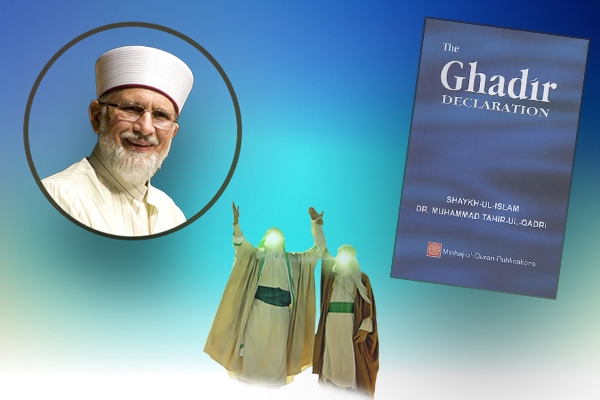‘The Ghadir Declaration’: Revisiting Ghadir Through Lens of a Sunni Scholar

The leading Sunni author tries in the book to address long-standing questions surrounding Islamic leadership and unity.
The event at Ghadir Khumm in the year 632 CE, which occurred shortly before the Prophet Muhammad’s (PBUH) demise, is recorded in numerous Islamic sources. According to historical reports, the Prophet (PBUH) stopped his caravan during the return from his Farewell Pilgrimage and, before a large gathering, delivered a sermon. At its heart was the statement: “For whomever I am his Mawla, ʿAlī is also his Mawla.”
This declaration has been the subject of extensive interpretation. Shia Muslims have long viewed it as an explicit nomination of ʿAlī ibn Abī Ṭālib (AS) as the Prophet’s successor.
Meanwhile, Sunni scholars have generally interpreted the statement in terms of love, respect, and spiritual authority rather than political succession. Tahir-ul-Qadri’s work uses exclusively Sunni sources to prove the event of Ghadir and bridge these interpretations.
About Muhammad Tahir-ul-Qadri
Muhammad Tahir-ul-Qadri is an internationally recognized Pakistani scholar, jurist, and founder of Minhaj-ul-Quran International, an organization committed to Islamic education. He holds a strong presence in both academic and religious spheres and is known for his work on topics ranging from counter-extremism to constitutional theory in Islam.
With a background that spans traditional religious training and Western academia, Tahir-ul-Qadri has authored more than five hundred books in Arabic, Urdu, and English. The Ghadir Declaration is part of his efforts to foster unity in Islamic thought through scholarly engagement.
Inside the Book
In The Ghadir Declaration, Tahir-ul-Qadri presents a focused textual and doctrinal examination of the sermon at Ghadir, arguing for its theological and ethical significance within the Sunni tradition. The central claim of the book is that the Prophet’s statement, points to a form of divinely guided leadership, even if not expressed in the terminology of political succession.
The book is notable for grounding its arguments in canonical Sunni hadith collections, legal opinions, and classical commentaries.
“Today is 18 Dhul-hijjah, the day when the Prophet (SAW) stayed at Ghadīr Khum after his return from Hajjat-ul-wadā‘ to Medina, and surrounded by the Companions (RA), he declared while raising the hand of ‘Alī al-Murtadā (SAW): ‘One who has me as his master has ‘Alī as his master’,” writes the author in the preface of the book.
“This was the declaration of ‘Alī’s spiritual sovereignty and its unconditional acceptance is binding on the believers till the Day of Judgment. It clearly proves that anyone who denies ‘Alī’s spiritual leadership in fact denies the Prophet’s leadership. This most humble follower of the Prophet (SAW) felt that some people deny this reality partlyout of ignorance and partly out of prejudice, which is spreading unnecessary tension in the Muslim community,” he added.
In another section of the preface, Tahir-ul-Qadri writes:
The gist of the discussion is that the Prophet’s declaration at Ghadīr Khum proved forever that ‘Alī’s spiritual sovereignty is in fact the Prophet Muhammad’s spiritual sovereignty. Though the door of prophethood was closed after the Holy Prophet (SAW), Allāh opened new avenues for the continuation of the Prophet’s blessings till the Day of Judgement. Some of these avenues were manifest, while others hidden. The hidden avenue led to spiritual sovereignty and ‘Alī al-Murtadā (AS) was the first person to hold this office. Then this chain of sovereignty passed down to his progeny and finally to the twelve Imāms. During this period, many leaders appeared on the spiritual horizon but they all, direcly or indirectly, expressed their allegiance to ‘Alī al-Murtadā (AS). No one was disaffiliated from him and this chain will continue up to the Day of Judgement until the appearance of the last Imām (spiritual leader), and he will be Imām Muhammad Mahdī (AS), the twelfth Imām and the last caliph. In his person, the manifest and the hidden paths which ran parallel to each other will be rejoined, as he will be the spiritual as well as the political legatee, and he will be the last person to hold these offices. Any one who denies Imām Mahdī (AS) will deny both the manifest and hidden forms of religion.
The book offers 50 narrations in proof of the event of Ghadir and what the Holy Prophet’s sermon and also virtues of Imam Ali (AS).
The author has anchored the discussion in Sunni sources to encourage readers from diverse theological backgrounds to engage critically and respectfully with the legacy of Ghadir Khumm.
One Amazon user, identified as Iqbal, praised the book in a review published in March 2013. “It is amazing to see how Imam Ali (the forth caliphate of Islam) is well respected and loved with proofs of traditions of Prophet (peace be upon him) from non-shia books,” wrote the user, adding, “This book increased my love for Imam Ali.”
Reporting by Mohammad Ali Haqshenas



